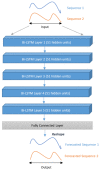Treatment Outcome Prediction Using Multi-Task Learning: Application to Botulinum Toxin in Gait Rehabilitation
- PMID: 36366149
- PMCID: PMC9654854
- DOI: 10.3390/s22218452
Treatment Outcome Prediction Using Multi-Task Learning: Application to Botulinum Toxin in Gait Rehabilitation
Abstract
We propose a framework for optimizing personalized treatment outcomes for patients with neurological diseases. A typical consequence of such diseases is gait disorders, partially explained by command and muscle tone problems associated with spasticity. Intramuscular injection of botulinum toxin type A is a common treatment for spasticity. According to the patient's profile, offering the optimal treatment combined with the highest possible benefit-risk ratio is important. For the prediction of knee and ankle kinematics after botulinum toxin type A (BTX-A) treatment, we propose: (1) a regression strategy based on a multi-task architecture composed of LSTM models; (2) to introduce medical treatment data (MTD) for context modeling; and (3) a gating mechanism to model treatment interaction more efficiently. The proposed models were compared with and without metadata describing treatments and with serial models. Multi-task learning (MTL) achieved the lowest root-mean-squared error (RMSE) (5.60°) for traumatic brain injury (TBI) patients on knee trajectories and the lowest RMSE (3.77°) for cerebral palsy (CP) patients on ankle trajectories, with only a difference of 5.60° between actual and predicted. Overall, the best RMSE ranged from 5.24° to 6.24° for the MTL models. To the best of our knowledge, this is the first time that MTL has been used for post-treatment gait trajectory prediction. The MTL models outperformed the serial models, particularly when introducing treatment metadata. The gating mechanism is efficient in modeling treatment interaction and improving trajectory prediction.
Keywords: botulinum toxin; clinical gait analysis; deep learning; gait rehabilitation; long short-term memory; multi-task learning.
Conflict of interest statement
The authors declare no conflict of interest.
Figures











Similar articles
-
Phase-Based Gait Prediction after Botulinum Toxin Treatment Using Deep Learning.Sensors (Basel). 2024 Aug 18;24(16):5343. doi: 10.3390/s24165343. Sensors (Basel). 2024. PMID: 39205037 Free PMC article.
-
Managing spasticity in pediatric cerebral palsy using a very low dose of botulinum toxin type A: preliminary report.Am J Phys Med Rehabil. 2000 Jul-Aug;79(4):320-6. doi: 10.1097/00002060-200007000-00002. Am J Phys Med Rehabil. 2000. PMID: 10892617 Clinical Trial.
-
Effects of botulinum toxin A in ambulant adults with spastic cerebral palsy: a randomized double-blind placebo controlled-trial.J Rehabil Med. 2011 Mar;43(4):338-47. doi: 10.2340/16501977-0672. J Rehabil Med. 2011. PMID: 21305227 Clinical Trial.
-
The effects of botulinum toxin (BTX-A) on spasticity of the lower limb and on gait in cerebral palsy.J Bone Joint Surg Br. 2003 Sep;85(7):943-8. doi: 10.1302/0301-620x.85b7.13967. J Bone Joint Surg Br. 2003. PMID: 14516023 Review. No abstract available.
-
Botulinum toxin type A in the management of equinus in children with cerebral palsy: an evidence-based economic evaluation.Eur J Neurol. 2001 Nov;8 Suppl 5:194-202. doi: 10.1046/j.1468-1331.2001.00052.x. Eur J Neurol. 2001. PMID: 11851748 Review.
Cited by
-
Phase-Based Gait Prediction after Botulinum Toxin Treatment Using Deep Learning.Sensors (Basel). 2024 Aug 18;24(16):5343. doi: 10.3390/s24165343. Sensors (Basel). 2024. PMID: 39205037 Free PMC article.
References
-
- Blumhardt L. Multiple Sclerosis Dictionary. Taylor & Francis; Abingdon, UK: 2004.
-
- Roche N., Boudarham J., Hardy A., Bonnyaud C., Bensmail D. Use of gait parameters to predict the effectiveness of botulinum toxin injection in the spastic rectus femoris muscle of stroke patients with stiff knee gait. Eur. J. Phys. Rehabil. Med. 2015;51:361–370. - PubMed
-
- Notice Patient—DYSPORT 500 UNITES SPEYWOOD, Poudre Pour Solution Injectable—Base de Données Publique des méDicaments. [(accessed on 29 April 2021)]. Available online: https://base-donnees-publique.medicaments.gouv.fr/affichageDoc.php?speci....
MeSH terms
Substances
Grants and funding
LinkOut - more resources
Full Text Sources
Medical
Miscellaneous

